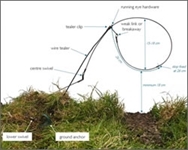Equipment
Always carry:
- Wire rope cutters (capable of cutting snare cable in single-handed use)
- Garden fork
- Shotgun or rifle
- Hook stick
The use of the garden fork and hook stick are described on the following page. If you do a lot of walking on hill ground, the garden fork may seem an encumbrance - before you reject it, be sure you understand why we recommend its use in handling non-target captures (below). To save your time later, it’s also sensible to carry spare snares and anchors, and some means of getting anchors out of the ground.
Avoiding non-target species
The Wildlife & Countryside Act 1981 didn’t address the questions posed by accidental non-target captures, so your position in law is rather uncertain. If you follow the guidelines in this leaflet, we believe you will have taken reasonable precautions to avoid the capture of non-targets.
As already stated, the use of snares fitted with a stop to prevent the noose closing tightly should be regarded as mandatory. It allows any animal that steps into a snare to pull its foot straight out again, and prevents the capture of small protected mammals like polecats and pine martens. It also helps prevent strangulation. If placed relatively far from the running eye, it can also allow the escape of brown hares, which may legally be caught by snares, but when caught are usually an unintended victim of fox snares.
Roe, fallow and red deer carry their heads far higher than a fox - except where they creep under obstacles. So avoid setting snares where runs pass under obstacles like fences and all animals must squeeze through with their heads at the same height. The use of wire tealers and coloured snares frees you from the need to use such places to disguise the snare. If there are muntjac in your area, either select prime ‘foxy’ sites away from dense cover, or avoid the use of snares entirely. We do not recommend you place poles or branches over snares to encourage deer to jump over snares. Foxes are likely to walk around obstacles, rather than underneath them. By creating a deer ‘jump’ you provide the perfect obstacle in which a captive might become entangled and injure itself.
Badgers are now abundant in most parts of Britain, so avoiding their capture is a necessary consideration for most gamekeepers. Badgers are far more habitual trail-users than foxes, so avoid snaring on obvious well-used badger runs, and avoid setting snares close to a badger sett. Badgers are usually caught only in low snares, so do not set snares lower than recommended above.
The Defra CoP states that snares must be set only at sites likely to be used by foxes, and not at sites where there is evidence of regular usage by non-target species. There is no indication of the geographical scale at which ‘site’ should be judged. Our understanding is that ‘site’ really equates to ‘run’ (after all, there can hardly be a land-holding in Britain without evidence of regular usage by badgers or deer or hares). The recommendation simply seems to require that you are careful to select runs where you have a strong chance of catching a fox rather than a badger or deer. If there is evidence of recent use by badgers (e.g. latrines, or badger hairs where the run passes under barbed wire) then you should not set snares on that run.
This will still leave you plenty of places to set snares. If you find fresh fox sign, but also fresh non-target evidence nearby, you need to find snare sites in the vicinity that give you a much stronger chance of catching the fox rather than the non-target. Look for faint runs leading between food-rich parts of the estate that are of interest to foxes, or alongside more regular runs but avoiding minor obstacles like low branches or puddles. You can even create your own new runs as described above.
Do not set snares close to rivers where otters are found. Do not set snares in capercaillie woods.
Keep farm workers and residents informed when you are running snares, so that they keep their dogs under control. It’s possible that signage may be required in Scotland under future legislation, reflecting the more open access by the public.
Get your FREE fox snaring guide from the GWCT team
Simply enter your email address below to download your essential free guide.
 What's inside your FREE fox snaring guide
What's inside your FREE fox snaring guide
✓ Fox control: Is it important?
✓ What are the alternatives to snaring?
✓ The main components of a well-designed snare
✓ Fox snares: Hardware vs practice
✓ Key controversies
Download free >